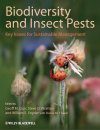About this book
Biodiversity offers great potential for managing insect pests. It provides resistance genes and anti-insect compounds; a huge range of predatory and parasitic natural enemies of pests; and community ecology-level effects operating at the local and landscape scales to check pest build-up. Biodiversity and Insect Pests brings together world leaders in theoretical, methodological and applied aspects to provide a comprehensive treatment of this fast-moving field.
Chapter authors from Europe, Asia, Africa, Australasia and the Americas ensure a truly international scope. Topics range from scientific principles, innovative research methods, ecological economics and effective communication to farmers, as well as case studies of successful use of biodiversity-based pest management some of which extend over millions of hectares or are enshrined as government policy. Written to be accessible to advanced undergraduates whilst also stimulating the seasoned researcher, Biodiversity and Insect Pests will help unlock the power of biodiversity to deliver sustainable insect pest management.
Contents
Preface, vii
Foreword, ix
Contributors, x
INTRODUCTION, 1
1 Biodiversity and insect pests, 3
Geoff M. Gurr, Steve D. Wratten and William E. Snyder
FUNDAMENTALS, 21
2 The ecology of biodiversity–biocontrol relationships, 23
William E. Snyder and Jason M. Tylianakis
3 The role of generalist predators in terrestrial food webs: lessons for agricultural pest management, 41
K.D. Welch, R.S. Pfannenstiel and J.D. Harwood
4 Ecological economics of biodiversity use for pest management, 57
Mark Gillespie and Steve D. Wratten
5 Soil fertility, biodiversity and pest management, 72
Miguel A. Altieri, Luigi Ponti and Clara I. Nicholls
6 Plant biodiversity as a resource for natural products for insect pest management, 85
Opender Koul
7 The ecology and utility of local and landscape scale effects in pest management, 106
Sagrario Gámez-Virués, Mattias Jonsson and Barbara Ekbom
METHODS, 121
8 Scale effects in biodiversity and biological control: methods and statistical analysis, 123
Christoph Scherber, Blas Lavandero, Katrin M. Meyer, David Perovic, Ute Visser, Kerstin Wiegand and Teja Tscharntke
9 Pick and mix: selecting flowering plants to meet the requirements of target biological control insects, 139
Felix L. Wäckers and Paul C.J. van Rijn
10 The molecular revolution: using polymerase chain reaction based methods to explore the role of predators in terrestrial food webs, 166
William O.C. Symondson
11 Employing chemical ecology to understand and exploit biodiversity for pest management, 185
David G. James, Sofia Orre-Gordon, Olivia L. Reynolds (née Kvedaras) and Marja Simpson
APPLICATION, 197
12 Using decision theory and sociological tools to facilitate adoption of biodiversity-based pest management strategies, 199
M.M. Escalada and K.L. Heong
13 Ecological engineering strategies to manage insect pests in rice, 214
Geoff M. Gurr, K.L. Heong, J.A. Cheng and J. Catindig
14 China's 'Green Plant Protection' initiative: coordinated promotion of biodiversity-related technologies, 230
Lu Zhongxian, Yang Yajun, Yang Puyun and Zhao Zhonghua
15 Diversity and defence: plant–herbivore interactions at multiple scales and trophic levels, 241
Finbarr G. Horgan
16 'Push–pull' revisited: the process of successful deployment of a chemical ecology based pest management tool, 259
Zeyaur R. Khan, Charles A.O. Midega, Jimmy Pittchar, Toby J.A. Bruce and John A. Pickett
17 Using native plant species to diversify agriculture, 276
Douglas A. Landis, Mary M. Gardiner and Jean Tompkins
18 Using biodiversity for pest suppression in urban landscapes, 293
Paula M. Shrewsbury and Simon R. Leather
19 Cover crops and related methods for enhancing agricultural biodiversity and conservation biocontrol: successful case studies, 309
P.G. Tillman, H.A. Smith and J.M. Holland
SYNTHESIS, 329
20 Conclusion: biodiversity as an asset rather than a burden, 331
Geoff M. Gurr, William E. Snyder, Steve D. Wratten and Donna M.Y. Read
Index, 340
Colour plates fall between pages 84 and 85
Customer Reviews
Biography
Geoff Gurr is Professor of Applied Ecology at Charles Sturt University in Australia. Over the last two decades he has worked on the ecology and management of pests in systems as diverse as pastures and forests. Much of his recent work has been with collaborators throughout Asia where insecticide resistance in sucking pests of rice has driven the development and adoption of biodiversity-based management strategies.
Steve Wratten is Professor of Ecology at Lincoln University, New Zealand and Visiting Professor at Charles Sturt University in Australia. His main research concerns evaluating and enhancing "nature's services" (ecosystem services). Using resource economics techniques, the existing value of these services (such things as biological control of pests) is estimated and then habitat manipulation ("ecological engineering") is used to enhance these services on farmland to provide profit and real evidence of sustainability. This work is done across several agricultural sectors but especially in vineyards.
William Snyder is Professor of Entomology at Washington State University, USA. With the help of a small army of students and postdocs, he explores the relationship between biodiversity and biocontrol. Recent work focuses on the relative importance of the two components of biodiversity, species number (richness) and species balance (evenness), and practical ways for farmers to harness biodiversity's many benefits.
Donna Read is a Research Assistant at Charles Sturt University, Australia with interests in rural sociology, agricultural economics and horticulture.



































